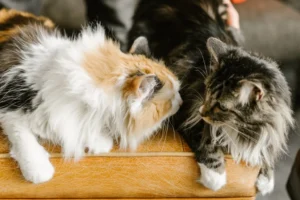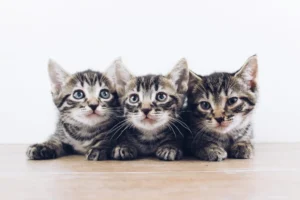Cats are known for their curious nature and unique eating habits, but why do they have a fascination with eating elastic bands? Let’s take a closer look at this unusual behavior and explore the reasons behind it.
Cats are notorious for their love of playing with small objects, but sometimes this playfulness can lead to them ingesting items like elastic bands. So, why do cats eat elastic bands?
Cats and Elastic Bands: An Unusual Temptation
We all know cats are curious creatures, but their fascination with elastic bands can be quite puzzling. Well, it turns out that cats are drawn to these stretchy objects because of their innate hunting instincts. In the wild, cats would often prey on small, moving objects like insects or rodents. So when they see an elastic band wriggling around, it triggers their hunting instincts, making it irresistible to pounce on.
Additionally, the texture of elastic bands can mimic that of prey animals, adding to the allure for our feline friends. The springy nature of these bands also provides a fun and engaging playtime for cats, keeping them entertained for hours on end.
The Dangers of Ingesting Elastic Bands
While cats may view elastic bands as toys or prey, ingesting them can lead to serious health risks. When cats swallow elastic bands, it can cause blockages in their digestive system, leading to discomfort, pain, and potentially life-threatening situations. These blockages can require surgical intervention to remove, putting your furry friend at risk.
Moreover, elastic bands can cause damage to the intestinal lining, leading to inflammation and infections. This can result in symptoms like vomiting, diarrhea, and lethargy. In severe cases, it can even be fatal if not promptly addressed by a veterinarian.
To keep your cat safe, always store elastic bands out of reach and provide plenty of safe and engaging toys to satisfy their hunting instincts and prevent them from turning to hazardous items. If you suspect your cat has ingested an elastic band, seek immediate veterinary attention to prevent any complications.
Curbing Your Cat’s Elastic Band Appetite
If you’re puzzled as to why cats seem to have a fascination with munching on elastic bands, you’re not alone. This behavior can stem from a cat’s natural instinct to hunt and play with string-like objects. However, eating elastic bands poses serious health risks, including potential blockages in the digestive system. To prevent this risky habit, store elastic bands out of your cat’s reach and provide them with safe and engaging toys to satisfy their urge to play. Additionally, consider increasing their playtime to keep them mentally and physically stimulated, reducing the likelihood of them seeking out inappropriate items to chew on. Remember, a proactive approach can help keep your furry friend safe and sound.
Alternatives to Elastic Bands for Cat Entertainment
When it comes to entertaining your feline friend, there are plenty of safe and enjoyable alternatives to elastic bands. Opt for interactive toys such as feather wands, laser pointers, or puzzle feeders to engage their natural instincts and keep them entertained for hours. You can also introduce scratching posts, cat trees, or tunnels to provide them with a variety of stimulating activities. Another fun idea is to create DIY toys using household items like cardboard boxes or paper balls. By offering a diverse range of toys and activities, you can keep your cat entertained and satisfied without the potential dangers associated with elastic bands. Remember, a happy and engaged cat is a healthy cat.
- Puzzle feeders: Make mealtime a fun challenge for your cat by using puzzle feeders that dispense food as they play.
- Catnip toys: Entice your cat with catnip-infused toys that can provide them with hours of entertainment.
- Cardboard scratching pads: Give your cat a safe outlet for their scratching instincts with cardboard scratching pads that help keep their claws healthy and sharp.
- Interactive electronic toys: Keep your cat engaged with interactive electronic toys that mimic the movements of prey, providing mental stimulation and exercise.
By offering a variety of safe and engaging toys, you can keep your cat entertained and prevent them from turning to elastic bands for playtime. Remember, a well-stimulated cat is a happy and healthy cat.
Understanding Feline Pica
Have you ever wondered why your cat is munching on elastic bands? Well, it could be a condition called pica. This disorder makes cats crave eating non-food items like rubber bands, paper, or even clothes. While the exact cause of pica in cats is not fully understood, it could be related to dietary deficiencies, boredom, stress, or simply the texture of the object. So, if your furry friend is snacking on elastic bands, it might be their way of seeking attention or addressing a nutritional need.
When to Seek Veterinary Assistance
If you notice your cat ingesting an elastic band, keep a close eye for signs like vomiting, diarrhea, lethargy, or a decrease in appetite. These could indicate that the elastic band has caused an obstruction in their digestive system. In such cases, it’s crucial to seek immediate veterinary help to avoid serious complications. Remember, prevention is key, so keep small objects like elastic bands out of your cat’s reach to ensure their safety and well-being.
Signs that indicate your cat may have ingested an elastic band:
- Vomiting
- Diarrhea
- Lethargy
- Decrease in appetite
Remember, your cat’s health is precious, so always be vigilant and proactive when it comes to their well-being. If you suspect they’ve eaten something they shouldn’t have, don’t hesitate to contact your vet for guidance and support.
Fun Facts About Cat Behavior
Cats have a unique way of showing affection, and sometimes, their behavior can leave us puzzled. One quirky habit that some cats have is eating elastic bands. But why do they do it? Well, one reason could be that cats are intrigued by the texture and smell of elastic bands, making them a fun and interesting toy to play with. However, it’s essential to keep in mind that ingesting these bands can be dangerous for your furry friend, as they can cause blockages in their digestive system.
If you notice your cat showing interest in elastic bands, make sure to keep them out of reach. Offer safe alternatives like interactive toys to satisfy their playful instincts without putting them at risk. Remember, a healthy and happy cat is a cat free from potential hazards, so always prioritize their well-being.
Unique Insight: Cats might be drawn to elastic bands because of the springy texture and the way they move unpredictably, stimulating their hunting instincts. By providing your cat with engaging toys that mimic this behavior, you can redirect their attention away from potentially harmful objects like elastic bands.
Alex, a passionate animal lover, has experience in training and understanding animal behavior. As a proud pet parent to two dogs and three cats, he founded AnimalReport.net to share insights from animal experts and expand his knowledge of the animal kingdom.









